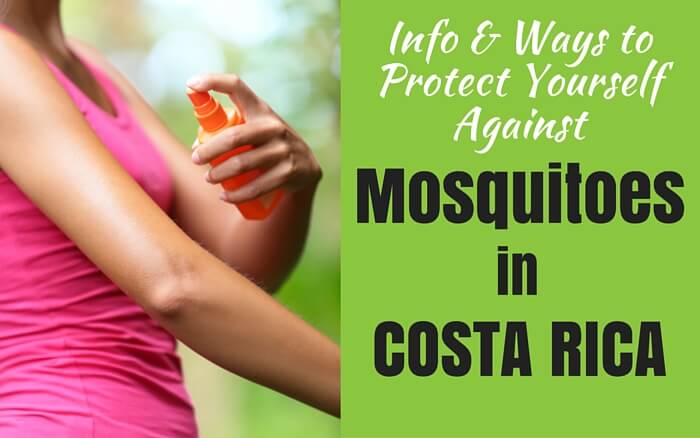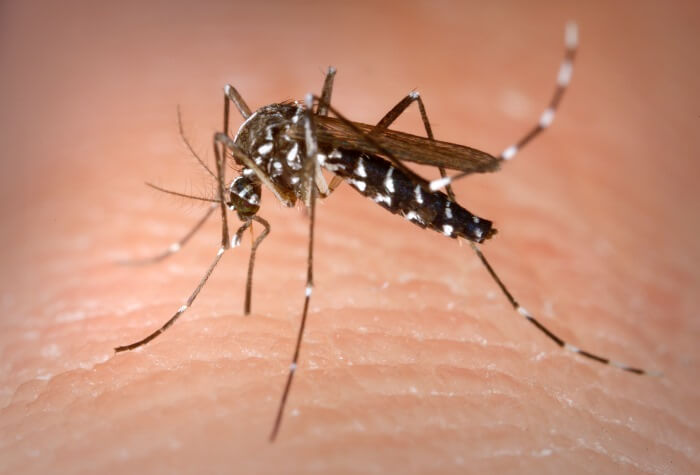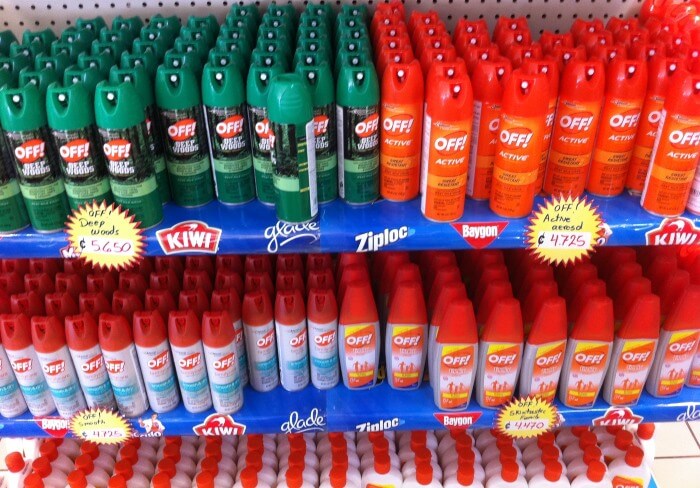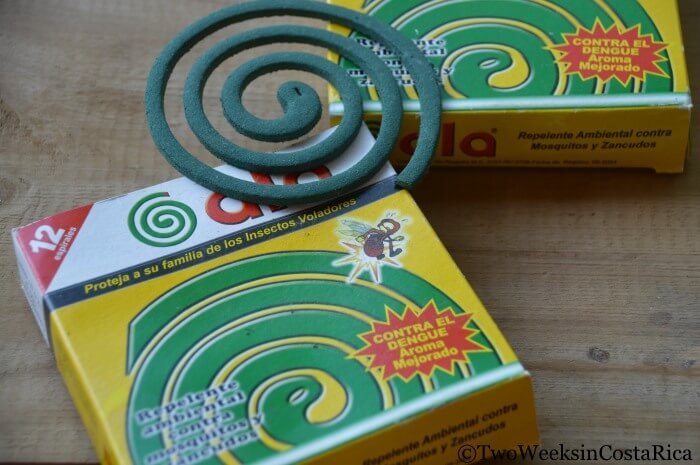Last Updated: August 1, 2025
Although Costa Rica has some amazing wildlife, not all creatures in its rainforests are postcard worthy. In fact, some, like the mosquito, are dreaded because of their ability to pass on diseases like Dengue, Zika, Chikungunya, and Malaria to humans. While these illnesses are a real concern in Costa Rica, a little bit of knowledge goes a long way in prevention. In this post, we’ll discuss Costa Rica’s most common mosquito-borne illnesses and give you some tips on how to stay safe during your visit.

Mosquito-Borne Illnesses in Costa Rica
As a traveler, you should know that Costa Rica’s government takes mosquito-borne illnesses very seriously and has aggressive campaigns to prevent the spread of these diseases. These efforts include public outreach to eliminate breeding sites as well as targeted chemical spraying in areas where diseases have been recorded.
Our friend actually worked for Costa Rica’s Ministry of Health for a while, eradicating mosquitoes, and told us that each day they were given the addresses of people who had been diagnosed with a mosquito-borne illness. They would then go door to door in those neighborhoods, handing out educational pamphlets, emptying standing water containers, and spraying to kill mosquito larvae.
These measures have helped control the spread of mosquito-borne diseases in Costa Rica, but conditions are constantly changing. At times, there are reports of small outbreaks in certain areas, and at other times, things are very quiet. We don’t want to scare you off from your vacation, but we also want you to know what’s out there. Our goal is to give you as much information as possible so that you can stay safe.
Here are the most common mosquito-borne threats that you need to be aware of in Costa Rica. Later in this post, we’ll cover our tips on how to prevent mosquito bites in the first place.
Note: The data we discuss below is based on official publications from Costa Rica’s Ministry of Health.
Dengue Fever
Dengue Fever is the most common mosquito-borne disease in Costa Rica. Its symptoms can vary from mild fever to incapacitating high fever, with severe headache, pain behind the eyes, joint and muscle pain, and rash. Although much less common, severe dengue (also known as dengue hemorrhagic fever) has symptoms of fever, persistent vomiting, abdominal pain, bleeding, difficulty breathing, and in rare cases, death.
Deaths due to severe Dengue are rare but do occur. In 2024, 7 people died from severe Dengue.
Cases of regular Dengue Fever have been on the rise in recent years. There were 30,649 cases in 2023 and 31,259 in 2024. The year 2024 was a record dengue year throughout the Americas, with Central America seeing a 98% increase in cases according to the Pan American Health Organization.
As of late July 2025, though, the number of cases this year in Costa Rica is only 2,436. This is an 80% decrease compared to last year at the same time (when 12,964 cases had been reported). Hopefully this trend continues! The Costa Rican government says that this is due to their aggressive campaigns to eradicate mosquitoes.
Chikungunya
Chikungunya is much less of a threat in Costa Rica and is also relatively new, occurring only since around 2015. In 2023, there were 91 cases, and in 2024, 45 cases. The newest data that the government has released for 2025 shows 5 cases as of late March 2025.
Symptoms of Chikungunya are an abrupt fever, which is usually accompanied by joint pain. Other signs include muscle pain, nausea, headache, fatigue, and rash. The joint pain associated with Chikungunya often can be very debilitating, but usually only lasts for a few days or weeks. Most patients recover fully, but in some cases joint pain can persist for months or even years.
Zika Virus
The Zika virus first appeared in Costa Rica in 2016 and spiked in 2017 when there were 359 confirmed cases. Today, Zika is much less prevalent. In 2023, there were 37 cases, and in 2024, there were 32 cases. The newest data we have for 2025 shows 4 cases as of late March 2025.
The symptoms of the Zika virus can include a mild fever, skin rash, and conjunctivitis. These symptoms normally last for two days to a week, but many people who have the disease show no signs at all. While Zika has relatively mild symptoms, the biggest danger according to the CDC (U.S. Center for Disease Control) is to women who are pregnant or planning to become pregnant due to the risk of the birth defect microcephaly.
Malaria
Malaria has only recently become a concern in Costa Rica. Historically, cases of Malaria have been very low and mostly imported, meaning that they originated in another country and the infected person traveled to Costa Rica.
In recent years, local transmission of Malaria has increased, but it is mostly regional. In 2023, there were 590 total cases, 474 of which originated in Costa Rica. In 2024, there were 232 cases that originated in Costa Rica. The majority of cases were in the region of Huetar Carib (around the city of Limon on the Caribbean coast) and the northern border with Nicaragua.
Notably, as of July 2025, the number of cases have decreased to only 7 so far this year. This is a 98% reduction from 2023 when you compare the same time frame (363 cases through July 2023 compared to 7 cases reported as of July 2025). Costa Rica’s Ministry of Health attributes this to its work with the CCSS (government health system) and other organizations to eliminate malaria. Costa Rica is part of an initiative called RMEI, which aims to eliminate malaria in the region.
Symptoms of Malaria can include fever, flu-like illness, chills, headache, muscle aches, and fatigue, typically appearing in 1-30 days after infection. While symptoms may start mild, malaria can become serious if not treated right away.
How to Prevent Mosquito Bites
The viruses we mentioned above are all transmitted by the bite of mosquitoes (Aedes in the case of Dengue, Zika, and Chikungunya, and Anopheles in the case of Malaria). In order to get you sick, the mosquito that bit you has to have previously bitten someone infected with one of the viruses.
Here are our tips on how to avoid bites from the start.

Watch Out for These Spots
Mosquitoes in Costa Rica usually won’t bother you if you’re sunbathing on the hot sand or walking in the heat of the day. But watch out if you are resting under palm trees, hiking on shady trails, or passing by wetlands, ponds, or rivers.
Also be extra careful in the morning and evening hours when it is a little cooler outside. We’ve been hit hard when eating at restaurants with outdoor seating. They love to hide out under the tables and bite your legs and ankles.
Mosquitoes are also much more prevalent during the rainy season months of May through November. With more water, they are able to reproduce faster so have higher numbers. Avoiding the rainiest areas of the country can help you avoid bites. Read our Weather post for more information about which areas of Costa Rica receive the most rain.
Insect Repellent
An obvious way to prevent bites is to use insect repellent.
DEET and Picaridin Options
The CDC recommends getting an EPA-registered insect repellent like one that contains DEET, Picaridin, IR3535, or oil of lemon eucalyptus. They now recommend choosing a concentration based on how long you will be outside (previously they recommended DEET at 20%).
DEET is available in concentrations ranging from 5-100%. The chemical being used (DEET) is the same, but the percentage has to do with how long the product will last. Most experts agree that 20-30% DEET can provide several hours of protection. Here’s a link to an article with more information.
You can buy repellent at most grocery and convenience stores in Costa Rica. For DEET, 10-20% is the easiest to find so if you’d like something stronger, be sure to bring your own. Also keep in mind that insect repellent is expensive here, at about $10 a can.
For everyday use, our family typically uses Off Family Care (10-20% DEET). For hiking or if we’ll be outside longer, we look for something with 20-30% DEET. For travel, Ben’s 30% Wipes are good to keep in a backpack or purse. Here are some other good travel-size options.
An alternative to DEET that is starting to become popular is Picaridin, which we also use regularly and really like. Picaridin-based repellents have been proven to be just as effective as DEET in preventing bites and also keep mosquitoes farther away. Instead of landing on you and not biting like with DEET, Picaridin is said to prevent the insect from landing in the first place.
We have used Sawyer’s 20% Picaridin lotion with success. We like the lotion because we can tell that it has been applied to cover all areas. It also doesn’t smell bad and dries after application.

Natural Options
While DEET is proven to be effective against mosquitoes, a lot of people try to avoid it because of its potential harm to human health. Fortunately, there are some more natural options that work fairly well in Costa Rica.
We have used a few different products. Repel’s Lemon Eucalyptus spray works just as well as our repellents containing DEET. Oil of lemon eucalyptus is supposed to be one of the best plant-derived ingredients for fighting mosquitoes according to scientific studies. It’s also on the CDC recommended list.
Though not recommended by the CDC, a premixed essential oil-based repellent that we like is doTerra TerraShield Outdoor Blend. It’s more expensive, but we’ve found it to be fairly effective against bites, not oily, and pleasant smelling too. Unfortunately, natural repellents are hard to find in most areas of Costa Rica so we recommend bringing these from home too.
Cover Up
Covering up is one of the best ways to prevent mosquito bites and lessens the need to use repellents. Some important tips are below. For a full write-up of what clothing to wear to prevent insect bites, read our post Mosquito Repellent Clothing for Costa Rica.
- When possible, cover all exposed skin by wearing light-colored, long-sleeved shirts and long pants made of synthetic material that bugs cannot easily bite through. Loose-fitting, breathable pants are a good option for Costa Rica since it is so hot.
- Sleep in air-conditioned or screened rooms. Keep in mind when looking at eco-lodges and hotels in Costa Rica that some accommodations are open air. This means that there is only a mosquito net covering the bed, and mosquitoes and other insects can slip through screen-less windows or slats in the walls. It is best to avoid this style of lodging if you’re prone to bug bites.
- If you are staying in open air accommodations like we describe above, at a minimum, make sure you have a bug net for sleeping.
Don’t be a Target
Many people don’t realize it, but mosquitoes can smell you from up to 50 yards away. To prevent them from honing in on your exact location, there are a few tactics you can use.
- If you are staying in one place for a while, like a vacation rental or cabin, be careful not to leave sweaty clothing and footwear hanging out to dry near where you sit. A study in the Journal of Chemical Ecology found that after a couple of days, the bacteria growing on sweaty clothes attracted many more mosquitoes than “fresher” sweaty clothes.
- You also can try to mask the chemical compounds that mosquitoes are attracted to by burning incense, citronella, or mosquito coils. Mosquito coils are available in grocery and convenience stores all around Costa Rica and cost only about $2 a package. When we sit outside, especially in the rainy season, we usually burn a couple of these coils on each end of our porch, setting up a sort of smoke screen. It doesn’t work perfectly but it definitely helps.

Conclusion
Mosquitoes in Costa Rica are not fun to talk about, but we know that they are on many people’s minds when traveling to the tropics. Remember, though, that not every mosquito is infected, and your chances of contracting something during a short visit are relatively low. The preventative measures we’ve discussed in this post will go a long way towards prevention and hopefully will ease your worries so that you can enjoy all of the other, more beautiful creatures that this country has to offer.
These are our tips for protecting yourself against mosquito bites in Costa Rica based on our experience living in the country. We are not experts in disease prevention or doctors and are not intending to give medical or other professional advice. If you’re unsure if you should travel to Costa Rica, consult the CDC (Center for Disease Control) and WHO (World Health Organization) websites for more information or seek the advice of a medical professional.
Additional Resources
- Costa Rica’s Ministry of Health: In Spanish, but can be translated. Covers all the major health issues facing Costa Rica.
- CDC: Info on travel advisories and ways to prevent mosquito bites.
- WHO: Detailed info on different outbreaks throughout the world.
Some of the links in this post are connected to affiliate programs we have joined. As an Amazon Associate we earn from qualifying purchases.
Have any tips to prevent mosquito bites? Leave a comment below.
Looking for more information to help you plan? Check out these posts:
Bugs, Spiders, and Snakes in Costa Rica – Learn what you can expect on your visit.
Drinking Water Safety in Costa Rica – Find out if it’s safe to drink the water or if you should buy bottled.
Health and Safety – Our Safety articles cover lots more information, including staying safe at the beach, renting Airbnbs, and other general tips.
Practical Travel – Get more practical tips on everything from getting a SIM card to dealing with currency.



